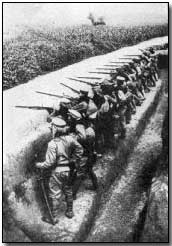 The world war is generally said to have begun on 1 September 1939 with the invasion of Poland by Germany and subsequent declarations of war on Germany by France and the United Kingdom.
But actually, War in Eastern front had started when the Japanese invasion of Manchuria began on September 19, 1931, when the Kwantung Army of theEmpire of Japan invaded Manchuriaimmediately following the Mukden Incident. The Japanese established a puppet state called Manchukuo, and their occupation lasted until the end of World War II.
The world war is generally said to have begun on 1 September 1939 with the invasion of Poland by Germany and subsequent declarations of war on Germany by France and the United Kingdom.
But actually, War in Eastern front had started when the Japanese invasion of Manchuria began on September 19, 1931, when the Kwantung Army of theEmpire of Japan invaded Manchuriaimmediately following the Mukden Incident. The Japanese established a puppet state called Manchukuo, and their occupation lasted until the end of World War II.
During the era of the weak
emperor Taisho (1912-26), the political power shifted from the oligarchic clique (genro) to the parliament and the democratic parties.

In the First World War, Japan joined the Allied powers, but played only a minor role in fighting German colonial forces in East Asia. At the following Paris Peace Conference of 1919, Japan's proposal of amending a "racial equality clause" to the covenant of the League of Nations was rejected by the United States, Britain and Australia. Arrogance and racial discrimination towards the Japanese had plagued Japanese-Western relations since the forced opening of the country in the 1800s, and were again a major factor for the deterioration of relations in the decades preceeding World War II. In 1924, for example, the US Congress passed the
Exclusion Act that prohibited further immigration from Japan.
 This earthquake devastated Tokyo, the port city of Yokohama, and the surrounding prefectures of Chiba, Kanagawa, and Shizuoka, and caused widespread damage throughout the Kantō region. Its force was so great in Kamakura, over 60 km (37 mi) from the epicenter, it moved the Great Buddhastatue, which weighs about 93 short tons (84,000 kg), almost two feet.
This earthquake devastated Tokyo, the port city of Yokohama, and the surrounding prefectures of Chiba, Kanagawa, and Shizuoka, and caused widespread damage throughout the Kantō region. Its force was so great in Kamakura, over 60 km (37 mi) from the epicenter, it moved the Great Buddhastatue, which weighs about 93 short tons (84,000 kg), almost two feet.
Estimated casualties totaled about 142,800 deaths, including about 40,000 who went missing and were presumed dead.
and the world wide depression of 1929 intensified the crisis.
During the 1930s, the military established almost complete control over the government. Many political enemies were assassinated, and communists persecuted. Indoctrination and censorship in education and media were further intensified. Navy and army officers soon occupied most of the important offices, including the one of the prime minister.
Already earlier, Japan followed the example of Western nations and forced China into unequal economical and political treaties. Furthermore, Japan's influence over Manchuria had been steadily growing since the end of the
Russo-Japanese war of 1904-05. When the Chinese Nationalists began to seriously challenge Japan's position in Manchuria in 1931, the Kwantung Army (Japanese armed forces in Manchuria)
occupied Manchuria. In the following year, "Manchukuo" was declared an independent state, controlled by the Kwantung Army through a puppet government. In the same year, the Japanese air force bombarded Shanghai in order to protect Japanese residents from anti Japanese movements.
In 1933, Japan withdrew from the League of Nations since she was heavily criticized for her actions in China.
In July 1937, the second Sino-Japanese War broke out. A small incident was soon made into a full scale war by the Kwantung army which acted rather independently from a more moderate government. The Japanese forces succeeded in occupying almost the whole coast of China and committed severe war atrocities on the Chinese population, especially during the fall of the capital Nanking. However, the Chinese government never surrendered completely, and the war continued on a lower scale until 1945.
In 1940, Japan occupied French Indochina (Vietnam) upon agreement with the French Vichy government, and joined the Axis powers Germany and Italy. These actions intensified Japan's conflict with the United States and Great Britain which reacted with an oil boycott. The resulting oil shortage and failures to solve the conflict diplomatically made Japan decide to capture the oil rich Dutch East Indies (Indonesia) and to start a war with the US and Great Britain.
In December 1941, Japan attacked the Allied powers at Pearl Harbor and several other points throughout the Pacific. Japan was able to expand her control over a large territory that expanded to the border of India in the West and New Guinea in the South within the following six months.
The turning point in the
Pacific War was the battle of Midway in June 1942. From then on, the Allied forces slowly won back the territories occupied by Japan. In 1944, intensive air raids started over Japan. In spring 1945, US forces
invaded Okinawa in one of the war's bloodiest battles.
On July 27, 1945, the Allied powers requested Japan in the Potsdam Declaration to surrender unconditionally, or destruction would continue. However, the military did not consider surrendering under such terms, partially even after US military forces dropped two
atomic bombs on Hiroshima and Nagasaki on August 6 and 9, and the Soviet Union entered the war against Japan on August 8.
On August 14, however, Emperor Showa finally decided to surrender unconditionally.
 Hiragana (平仮名, ひらがな?) is a Japanesesyllabary, one basic component of theJapanese writing system, along withkatakana, kanji,
Hiragana (平仮名, ひらがな?) is a Japanesesyllabary, one basic component of theJapanese writing system, along withkatakana, kanji, The kanji that make up Japan's name mean "sun origin", and Japan is often called the "Land of the Rising Sun".
The kanji that make up Japan's name mean "sun origin", and Japan is often called the "Land of the Rising Sun".















 Japan declared war on Germany on the 23rd August 1914, although Japanese ships had joined with the Royal Navy in attempting to prevent Admiral von Spee's German Pacific squadron from escaping from Kiaochow.
Japan declared war on Germany on the 23rd August 1914, although Japanese ships had joined with the Royal Navy in attempting to prevent Admiral von Spee's German Pacific squadron from escaping from Kiaochow.























































